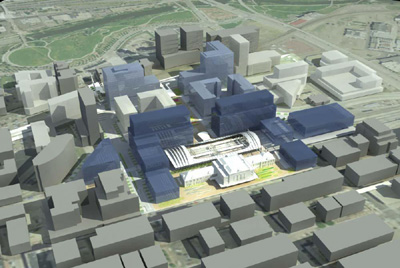Denver Urbanism: Union Station, the soon–to–be pride of Denver

Ken Schroeppel is a faculty member of the College of…
To celebrate this Pride issue, I think it’s appropriate to highlight what’s going on at Denver Union Station. From an urbanism perspective, if there’s anything you should take pride in, it’s what’s happening there. The area is undergoing a massive transformation taking it both “back to the past” and “forward to the future” at the same time.
Denver Union Station dates from 1881 (the north and south wings), and rail was the city’s primary transportation gateway for about a century. Prior to World War II, commercial aviation and interstate expressways weren’t yet commonplace, so if you traveled to Colorado, chances are you arrived or departed at Union Station. After World War II, planes and cars took over and rail transportation declined, leaving Union Station a very quiet, lonely place for decades. Now, thanks to RTD’s FasTrack’s program, Union Station will again be a bustling transportation hub of the 122 miles of new rail transit being built in Denver. Here are the Union Station project’s four major components:
Transit: The new light rail station next to the Millennium Bridge opened in August, 2011. RTD’s Southwest (C), Southeast (E), and West (W) lines arrive there. In 2016, RTD will launch commuter rail service to Union Station. (Commuter rail is a heavier–gauge train than light rail; otherwise, there’s not much difference to the average traveler.) The new commuter rail platforms are under construction immediately behind the historic station, surrounded by a big white canopy. New commuter rail lines coming to Union Station will include the East line to Denver International Airport, the Gold line to Wheat Ridge and Arvada, the North line to several north metro suburbs, and the Northwest line to Boulder and Longmont.
Historic Station Renovation: A local development team is currently restoring the historic station to its original grandeur. The Great Hall will receive a major makeover and will continue as the main transit waiting area, with restaurants and retail spaces nearby. Additionally, the upper floors will be converted into a new boutique hotel. By summer of 2014, you’ll be able to travel, shop, dine, party, and sleep at Union Station!
Public Spaces: Several public plazas are planned for the project. The main one is Wynkoop Plaza, located in front of the historic station along Wynkoop Street, which is destined to become Downtown’s next great public space where everything from big festivals to solo musicians will happen throughout the year.
Private-Sector Development: In addition to all this public investment, there’s a ton of private-sector development taking place around the station. Over a dozen new mixed–use projects consisting of offices, hotels, apartments, and retail shops are currently under construction or planned. Have you seen all the construction cranes in the area? It’s amazing!
So what does this mean and why should we take pride in it? This is not just some run–of–the–mill construction project. Between the public infrastructure and private developments, more than $1 billion in investment happening right now will shape the way that you and future Coloradoans move about the region for the next century, and that’s not counting the $500 million new terminal/transit development at DIA or the additional investment in all the FasTracks lines. These are serious transformations that, decades – maybe even a century from now – people will see as some of the wisest, most strategic investments this region has made. Many cities around the country are scrambling to invest even a fraction of what Denver is committing to transit infrastruture. Whether you ever take a train into Denver Union Station or not, take pride in the fact that Colorado’s main urban center is growing, thriving, and committing to a more sustainable and prosperous future.
What's Your Reaction?
Ken Schroeppel is a faculty member of the College of Architecture and Planning at the University of Colorado Denver. He teaches in the Master of Urban and Regional Planning program. Ken is also the founder of the DenverInfill and DenverUrbanism website and blogs, which offer aspects of sustainable design and urbanism in the Mile High City. Find them at DenverInfill.com.




